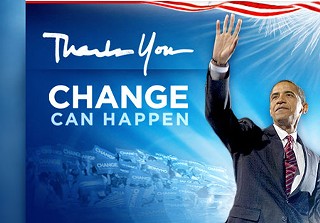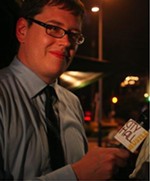Web Prez
Crafting campaign, inside and out
By Wells Dunbar, Fri., March 6, 2009
Among the many "firsts" in Barack Obama's historic campaign, his unprecedented incorporation of graphic design and social-networking technology seems pretty small in comparison. Yet when we think of the campaign, its iconic deep blues and clean white type spring to mind; similarly, cornerstones of information for many voters this election were Obama's Facebook and MySpace pages and the texts sent to their phones. Simply put, Obama's ascendancy has bestowed further respectability on graphic design, new media, and social networking in politics, heretofore an afterthought –if that.
What Change Looks Like
Designer Scott Thomas was hired on in September 2007; he and John Slabyk made up the campaign's new media team. "We were essentially given [every] task which directly related not only to the design of the website but also branding –posters, placards, anything that stood in front of Barack or behind Barack while he was speaking was essentially our responsibility." Coming from advertising, where ad campaigns are focus-grouped and calibrated for months on end, the speed with which Thomas had to work was shocking. "We were very used to a [certain] process and design, spending lots of time thinking stuff out, doing storyboards, thinking about the campaign we would launch. [Here, it was] 'design something; you have two weeks to do it.' ... We were having to design on the fly and gradually evolve things."
The new Obama website launched in December 2007. While the interactive, social-networking tools on the site – tools Thomas calls "fundamental to our success as a campaign" – were powered by Blue State Digital, a company of consultants from Howard Dean's Web-savvy 2004 presidential campaign, Thomas and company encoded the site with the Obama aesthetic. Instantly recognizable, he describes it as "the cool blue," "the gradient" of darker to lighter blue, and "the light-emanating aspect" of an ethereal shine lightening the edges of the image. Once established, it would be reproduced across all campaign materials with an aesthetic rigor unseen in a political campaign. "Type consistency was really important to us. Color consistency was really important to us. ...We wanted to make sure that whenever you see any part of the campaign, whether it be a sign or pamphlet or ticket, a website or a banner ad – we wanted everything to have a very similar look and feel. And that consistency, I think, spoke volumes to the consistent message that Barack was delivering throughout the campaign."
Of course, there was one other important brand consistently applied to the campaign: the iconic sunrise logo. Created earlier in the campaign by graphic designer Sol Sender, Thomas says, "It was a very strong tool to use; it was something that politicians haven't traditionally done well in the past." With its symbolism of a new day dawning,"it represented the campaign and the movement that was occurring much more than it represented Barack Obama himself or Barack Obama's campaign. It represents a larger whole."
"This is the first political campaign that's had in-house designers as staff," says Thomas. And in that sense, it represents an acceptance and recognition of the importance of design in building and sustaining a message. "The design has gotten a lot of people to turn their heads and say, 'Wait a minute – why did we never see this from any campaigns prior?' After the fact, people are starting to realize the potential of good, consistent communications. I think that if a politician wants to communicate really, really well and efficiently, they would need to have a designer, not necessarily just doing all their work but having them sit down at the strategy table. ... If you say one thing, then type it out in a typeface that doesn't necessarily visually communicate that message, that's a lost message."
Txt to Vote
With the Obama "brand" firmly established, colonizing existing Web communities and social networks and rallying voters and volunteers through text and mobile messaging fell on the shoulders of Scott Goodstein, external online director for the campaign. "Wherever we could figure out ways to organize," he says, "I was tasked with building and maintaining a presence and a culture throughout the Web."
This involved setting up on familiar social networks –MySpace, Facebook, and Twitter, for example –but also targeting niche sites organized by ethnicity and lifestyle, where the campaign could address specific concerns. On Disaboom, a network for the disabled, Goodstein says, "You're going to put out information about Barack Obama and Barack's health-care and tax policies and economy ...but you're also able to have a conversation about 'how is health care really affecting the disabled community?' in their own unique way." The same targeting applied to fundraising efforts. When younger MySpacers might balk at direct financial appeals, the campaign offered T-shirts for donations.
Turning awareness into action – "getting online to offline" –was another critical component. This is called lifestyle marketing, reaching voters where they shop, party, or entertain themselves, and was accomplished by a mix of online and offline activity. Utilizing practices modeled on record-label street teams, volunteers postered, pushed 1-800 numbers with voter registration info, and offered voter registration at places like the Warped Tour while building the message with videos and advertising online and in print. Modern music marketing was a fit for Goodstein; in 2004, he founded the groups Punk Voter and Rock Against Bush, which sought to swell voter registration. "Four years ago, it was all done separate from the campaign with a lot of independent groups. ...But this time, it was all coordinated inside the campaign."
One of the most successful techniques applied was the campaign's massive text-messaging apparatus. While Goodstein's mum on specific figures, he says they had more than a million unique subscribers. They also stayed apace with evolving mobile technology; an Obama iPhone application facilitated more than 50,000 calls on behalf of the campaign. Goodstein doesn't "drink the Kool-Aid" that texting allowed Obama to circumvent the media and directly address the public, as texts only addressed supporters who signed up. "Nonetheless, there's next to no spam on your phone. You're going to open up your text message. ... I personally only text message with about a half a dozen of my friends, my nephew, and Barack Obama. ...Once the gateway gets cluttered and there's a lot of spam on it, things like that, it's probably not going to be as effective. But right now, it's one of the most effective and efficient forms of communication."
Goodstein stresses that success in campaigning online requires more than setting up some accounts, collecting some phone numbers, and calling it a day; just as it was for Obama's design team, integration was key to success. "I was able to engage in a way with our social networks that really incorporated our field team, our communications team, our paid media team," he says. But first, he had to demonstrate the technology's value. "I guess the question I was asked first was, 'What practical purpose does text messaging, does social networking have?' What value-add does it have? If you can't prove your value-add, you shouldn't be doing it." (For instance, most campaigns won't have to go as wide as Obama's. "It probably doesn't make sense to be on 50 or 100 social networks," Goodstein says. "It only makes sense to be on five or six. But at this point, it's hard to say that Facebook isn't going to add value to your organization.") Once Goodstein demonstrated the tech's practicality, "our campaign allowed us to grow with it in a very natural way. It wasn't like the new media kids are sitting over in the corner, playing with some social network that no one understands."
Of course, there's another thing Goodstein hastens to add: "We had an amazing candidate with an amazing message ...so all the fun stuff we did with social networks, lifestyle marketing, and text messaging needed to have, at the core, a candidate people believed in."
Related Panels
What Your Startup Can Learn From Barack Obama and Howard Dean
Saturday, March 14, 11:30am-12:30pm, Room 9
Designing Change in America
Tuesday, March 17, 3:30-4:30pm, Room 8
As Obama's design director for new media, Scott Thomas crafted the look of the campaign. Here he breaks it down:
Typeface: The Obama campaign utilizes the Gotham typeface, designed by New York based Hoefler & Frere-Jones. Noting the font was inspired by signs for New York's Port Authority, Thomas says, "There's something kind of very American about the typeface." Additionally, its "nice geometric proportions" allowed for setting type quickly – a must in a campaign.
Color: "Color consistency was really important to us," says Thomas. "We wanted to make sure that any materials we were putting out, they were mainly blue." The deep blue worked "in line with not only with being kinda American and this great hopeful color, but aligning him to the Democratic side of politics."
Gradient: Another hallmark of the campaign's design was the ethereal light around the edges of images, best viewed on digital images like the campaign website. Thomas describes it as "a kind of hopeful, new day dawning, That's really what we were trying to go for." – W.D.













